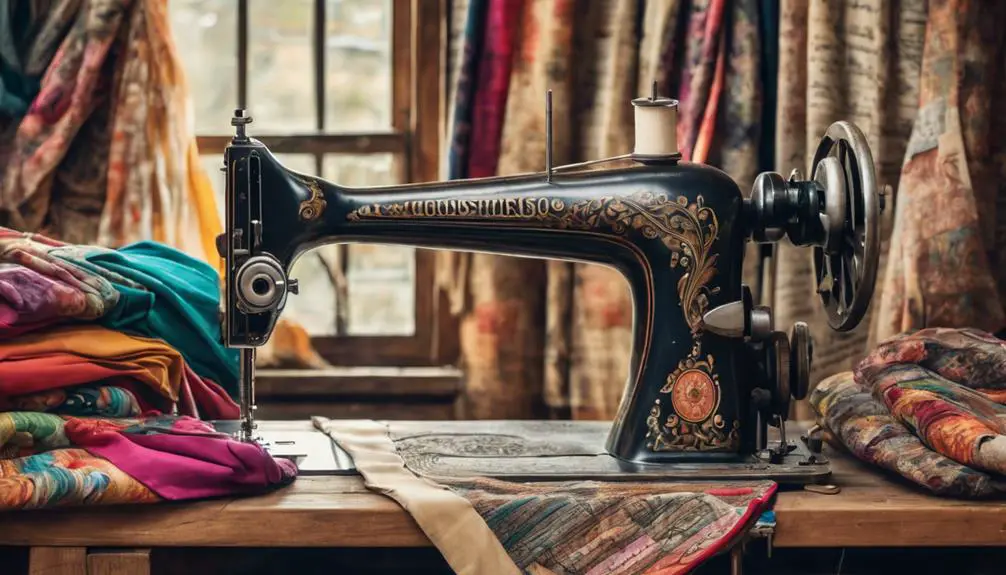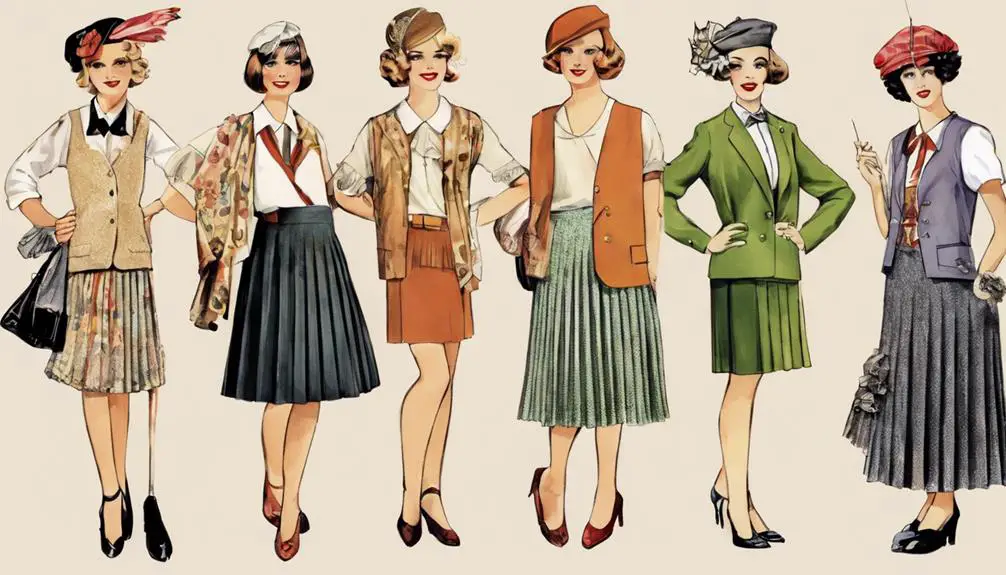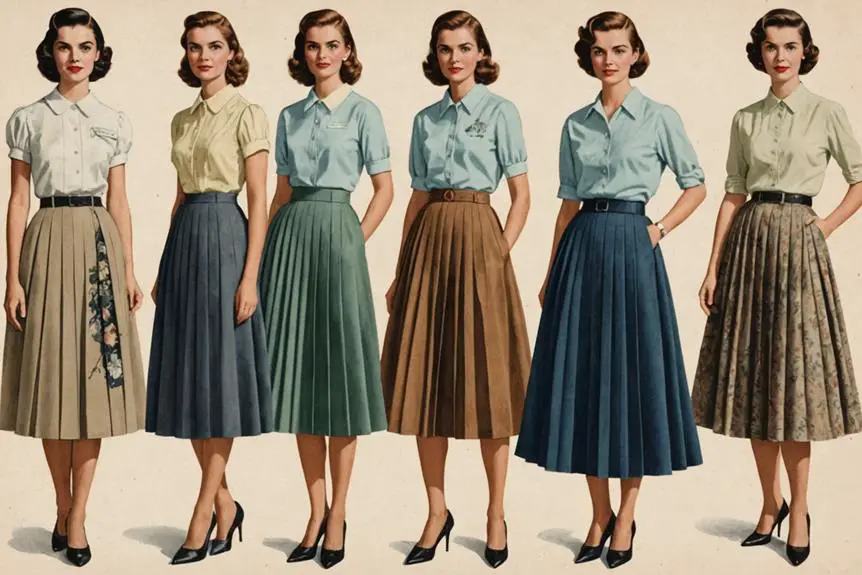You might not know that the pleated skirt dates back to ancient Egypt, where it was more than just a fashion choice; it represented nobility and status. As you explore its journey through various cultures and eras, you'll find that pleats have transformed from symbols of wealth to versatile wardrobe essentials. The innovations of designers in the 20th century redefined how pleats could be used, but their significance goes far beyond aesthetics. What role do these skirts play in today's fashion landscape, and how might they evolve in the future?
Origins of Pleating

Pleating has its roots in ancient Egypt, where it served as a symbol of status among royalty and nobility. Can you imagine walking around in those stunning, pleated garments? They didn't just look beautiful; they told everyone who wore them was important! The ancient Egyptians knew how to show off their style, and pleating was a big part of that.
You see, they created these intricate designs using a special method. They'd immerse fabric in liquid gum, which sounds a bit messy, right? But then, they'd use heavy pressing tools to get those perfect pleats. Talk about dedication to fashion! Ancient Egyptian women often wore long skirts made from semi-transparent linen, and those pleats helped enhance the drape and flow of the fabric. It's like the fabric danced around them!
And here's something cool: you can actually see historical artifacts, like a rare pleated coat from around 2000/1960 BC, at the Lyon Fabrics Museum. Isn't it mind-blowing to think about how these styles have stood the test of time? You can also check out similar pleated clothing preserved in places like the Louvre Museum in Paris.
Techniques Through the Ages
Let's take a fun look at how pleating techniques have changed over the years! From the ancient Egyptians who used gum and heavy tools to create royal pleats, to the innovative heat-setting methods of Issey Miyake in the '80s, there's so much to explore. Isn't it fascinating how these styles not only shaped fashion but also reflected culture and status?
Ancient Egyptian Pleating Methods
In ancient Egypt, artisans developed innovative pleating methods that showcased their skill and the wearer's social status. Imagine watching skilled craftsmen immerse fine, semi-transparent linen in liquid gum, then using heavy pressing tools to create stunning pleated garments. These techniques weren't just about looks; they were a sign of wealth and nobility. Women often wore long, flowing skirts while men preferred pleated tunics, making it clear that everyone loved a good pleat!
One of the coolest pieces from this era is a rare pleated coat from around 2000/1960 BC, safely kept at the Lyon Fabrics Museum. It's like a time capsule of fashion history! You can also find similar pleated garments at the Paris Louvre Museum, showing just how important these techniques were to ancient Egyptian culture.
Innovations in the 20th Century
The 20th century witnessed a remarkable transformation in pleating techniques, blending artistry with innovation. Can you imagine how exciting it must have been? In 1909, Mariano Fortuny revolutionized the pleated skirt with his "Fortuny" pleat, using intricate hand methods to create lightweight, flowing garments that reminded us of ancient Greek styles. His Delphos dress, with up to 450 folds of unlined pleated silk, celebrated the beauty of the female form like never before.
Fast forward to the 1980s, and you meet Issey Miyake, who introduced permanent pleats using heat-setting techniques. This meant garments could maintain their shape while being super lightweight—talk about a game changer! Plus, his collaboration with ballet choreographer William Forsythe led to a new knitted fabric that could hold pleats, merging functionality with sheer artistry.
Thanks to advances in synthetic fabrics, modern pleating techniques have really expanded. Now, designers can create everything from classic pleated skirts to laser-cut styles that show off creativity and versatility. Isn't it amazing how pleats have evolved? It's like a whole new world of fashion opened up!
Contemporary Pleating Techniques
Evolving from traditional methods, contemporary pleating techniques showcase a blend of artistry and innovation that reshapes modern fashion. You'll notice that knife pleating creates sharp, angular folds, perfect for a sleek look. On the flip side, box pleating offers wider, flatter pleats that are super popular in today's skirts.
Have you heard about Issey Miyake? He revolutionized pleating in the '80s by introducing heat-setting technology, which allows pleats to become permanent, giving garments a cool sculptural vibe. Then there's the Gérant Lognon workshop, known for its intricate pleating methods. They use steam ovens to set pleats, making each piece a unique work of art!
And let's not forget about laser-cut pleating techniques! They've taken the fashion world by storm, enabling designers to create precise patterns that were once just a dream. So, whether you're rocking a high couture look or something more casual, modern pleat styles add texture, structure, and movement to your wardrobe. Isn't it amazing how these techniques can transform a simple garment into something extraordinary? You might want to explore these pleated wonders in your next outfit!
Evolution in the 20th Century

Pleated skirts transformed dramatically during the 20th century, particularly after World War II when women's fashion began embracing more feminine silhouettes. Can you imagine how exciting that was? After years of war, women were ready to express themselves in style! Designers like Christian Dior brought pleated skirts into the limelight, making them a staple in both high fashion and everyday wear. Additionally, the cultural impact of fashion brands, much like Ralph Lauren's vintage appeal, influenced how pleated skirts were embraced across various demographics. But let's take a step back to 1909, when Mariano Fortuny wowed everyone with his Delphos dress. This dress featured intricate permanent pleats that turned heads and inspired future fashion trends. Fast forward to the 1980s, and Issey Miyake took pleating to a whole new level with his PLEATS PLEASE line. He used a lightweight knitted material that allowed for permanent pleating, making these skirts not just stylish, but super functional too.
The introduction of synthetic fabrics like polyester mid-century made pleated skirts even more accessible. Suddenly, everyone could rock a pleated skirt without breaking the bank! You could wear one to school, work, or even a party. They became the go-to choice for those wanting to mix comfort with a touch of elegance.
Cultural Significance
When you think about pleated skirts, do you realize just how much they've meant to different cultures throughout history? From the royal vibes of ancient Egypt to the stylish nobility of China, these skirts have always been a big deal in showing off social status. Plus, who can forget the pride they represent in places like Scotland?
Status Symbol in Fashion
Throughout history, pleated skirts have consistently symbolized status and sophistication across various cultures. Think about it—ancient Egyptians wore pleated skirts to showcase their wealth, using fine linen and intricate designs. Those skirts weren't just clothing; they were a clear message that the wearer belonged to the upper class. Fast forward to the Song Dynasty in China, where nobility sported elaborate pleats, reflecting their social status and cultural identity.
In medieval Europe, the aristocracy embraced pleats, with ruffs and collars acting as the ultimate fashion statements. And let's not forget Scotland, where kilts with pleats have long represented cultural heritage and social standing.
Today, pleated skirts are back in style, serving up that same feeling of elegance and class. When you wear a pleated skirt, you're not just dressing up; you're connecting with a rich history of fashion that screams sophistication. Who doesn't want to feel like royalty, right? So, when you rock those pleats, remember you're part of a timeless tradition that's all about status. Isn't that cool?
Cultural Variations in Style
The allure of pleated skirts extends beyond mere elegance; they carry deep cultural significance that varies from one society to another. Ever wondered why these skirts are so special? Well, let's take a quick trip around the world!
In ancient Egyptian times, nobility donned finely pleated fabric that signified wealth and status. Imagine strutting around in a beautifully pleated linen garment, feeling like royalty! Fast forward to Korea during the Goryeo dynasty, where pleated skirts became a staple of the traditional Hanbok, bursting with vibrant colors and intricate designs that reflect cultural identity.
Don't forget about Scotland! The kilt, with its distinctive pleats, has been a symbol of national pride since the 16th century, allowing wearers to move freely during traditional dances. Over in China, during the Song Dynasty, pleated skirts shifted fashion to a waist-level silhouette, blending style and cultural meaning beautifully.
Today, designers globally still draw inspiration from these historical pleating techniques, creating modern styles that honor those rich cultural heritages. So next time you see a pleated skirt, remember, it's not just a piece of clothing; it's a story woven into fabric!
Historical Context and Meaning
Tracing the origins of the pleated skirt reveals a rich tapestry of historical significance and cultural meaning. Can you imagine wearing a skirt that once signified royalty in Ancient Egypt? Back then, only the elite could sport pleats, showcasing their wealth and status. Fast forward to the Goryeo dynasty in Korea, where pleated skirts became key elements of the traditional Hanbok. They weren't just fashion statements; they represented cultural identity!
During the Middle Ages in Europe, the aristocracy embraced pleated styles, like ruffs and collars, as symbols of sophistication. Isn't it fascinating how fashion can reflect social standing? Then came the post-WWII era, when pleated skirts re-emerged, embracing a more feminine silhouette. This marked a shift towards elegance paired with practicality—perfect for women stepping into new roles.
Today, pleated skirts are everywhere! They blend historical styles with modern fashion trends, making them versatile pieces in any wardrobe. Whether you're dressing up for an event or keeping it casual, pleats can elevate your look. So, why not give the pleated skirt a try? You'll be wearing a piece of history while exuding style!
Modern Fashion Trends

In recent years, pleated skirts have firmly established themselves as a must-have in modern fashion, enchanting audiences both on the runway and in everyday street style. You might've noticed them popping up everywhere, from casual brunches to formal events. Big names like Chanel and Christian Dior have embraced this trend, showcasing stunning pleated designs that wow us all. Additionally, the tailoring of pleated skirts has evolved, with modern techniques allowing for a flattering fit that complements various body types, making them a favorite among fashion enthusiasts. Tailoring Vintage Bottoms can enhance the overall look and comfort of these stylish pieces.
But what makes pleated skirts so special? It's their versatility! You can easily dress them up with a fancy top and heels or keep it laid-back with a graphic tee and sneakers. Plus, they're not just for one age group; everyone from teens to grandmas loves rocking this classic look.
A Spanish designer created some unique styles that take garment pleating to the next level, mixing traditional techniques with modern flair. Innovative fabric technologies, like heat-setting and laser-cutting, mean that these skirts hold their shape and texture while still being super comfy. How cool is that?
And let's not forget about street fashion! You'll see pleated skirts strutting down the streets of Milan, Paris, London, and New York, proving their timeless quality and universal appeal. So, if you haven't added a pleated skirt to your wardrobe yet, what are you waiting for? Immerse yourself in this trend and find your perfect pleated piece. Trust me, you won't regret it!
Future of Pleating
As pleated skirts continue to dominate modern fashion, their future looks bright and promising. You're about to see a resurgence of pleating in street fashion, where designers are getting super creative. They're mixing historical vibes with modern styles, making pleated skirts even more exciting! Plus, with advancements like laser-cutting and digital fabric manipulation, the art of pleating is evolving. Imagine skirts that move and flow in ways you never thought possible! Chenille fabric features a soft, fuzzy texture that enhances comfort, highlighting the significance of choosing the right materials in fashion.
Sustainability is also taking center stage. Brands are focusing on eco-friendly materials and production methods, so you can feel good about your fashion choices while rocking that elegant pleated look. Isn't that awesome?
You'll also notice the influence of iconic designers like Issey Miyake. His innovative techniques are inspiring contemporary collections, where pleating is used as a canvas for wild patterns and fabric experiments. Talk about a fashion playground!
Ongoing exhibitions and events around pleating are creating buzz and excitement. They're fostering a deeper appreciation for this technique, ensuring pleating remains a crucial part of fashion discourse. So, whether you're a fashion fanatic or just starting to explore, there's never been a better time to embrace pleated skirts.
Keep your eyes peeled on the runway and in stores. The future of pleating is not just bright; it's dazzling! With all these exciting trends and innovations, you'll definitely want to add a pleated skirt to your wardrobe soon. Are you ready to join the pleating revolution?
Frequently Asked Questions
What Is the Purpose of a Pleated Skirt?
A pleated skirt's purpose lies in its design versatility and fabric choice. It enhances your silhouette while providing comfort and movement, making it perfect for various occasions, from casual outings to more formal events.
What Era Was Pleated Skirt?
Imagine walking through history's tapestry, where pleated skirts weave stories of fashion evolution. From ancient cultures to modern runways, their cultural significance shines bright, symbolizing status, artistry, and timeless elegance across various eras.
Who Invented Pleating?
You'll find that pleating techniques have evolved over centuries, with Mariano Fortuny being a key figure in their invention. His innovative designs highlight the historical significance of pleating in shaping modern fashion trends you see today.
What Is the Purpose of Accordion Pleats?
Accordion pleats enhance your wardrobe by allowing flexibility and movement. These pleat techniques create a dynamic silhouette in your clothing, perfect for both casual and formal occasions, making accordion fashion a versatile choice for any style.





Ke?p on writ?ng, great job!